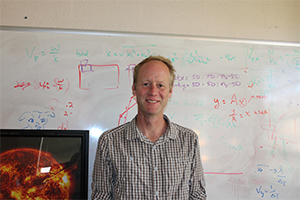Jason Jackiewicz, PhD
Principal Investigator of Sunspot and APO

As Head of the Astronomy Department at NMSU, Dr. Jackiewicz serves as the principal investigator of Sunspot Solar and Apache Point Observatories in Sunspot, NM. Some of his duties include overseeing operations at both observatories and managing the university-based consortium. Dr. Jackiewicz also works with the telescopes at both sites for research and to instruct astronomy students, teaching them valuable techniques in instrumentation, observation, and data collection.
Dr. Jackiewicz specializes is helioseismology, which is the study of the Sun’s interior through analyzing its quakes (yes, the Sun quakes just like the Earth!). He utilizes both the Dunn Solar Telescope at Sunspot and the nighttime telescopes at APO to infer the interior properties of the Sun as well as other planets. One of his projects includes a month-long observation of Jupiter, which happens annually and receives funding from NASA. During this time, Dr. Jackiewicz, his students, and Sunspot’s team of astronomers switch to a schedule which allows them to study Jupiter at night, using special instruments to collect data about its interior and exterior properties.
After earning a PhD in Theoretical Physics from Boston College, Dr. Jackiewicz moved to Europe, where he resided for a short time in Italy then Germany. While working at Max Planck Institute for Solar System Research in Germany, he began his career in astronomy. For the last fifteen years, he has worked as a professor of astronomy at New Mexico State University and has helped build their Solar Physics program. In his spare time, Dr. Jackiewicz enjoys the outdoors. He and his wife play tennis, garden, and keep bees. At Sunspot, one of his favorite things to do is hike the trails, and when asked what he thought made the Sunspot Solar Observatory so special, Dr. Jackiewicz said:
“It’s an impressive facility, even if you don’t know astronomy or do astronomy. Just the size and the weight and the complexity and the age of it, that it still functions, and that it’s still producing great data and science—that always hits me when I’m there. And the dedication of people to keep operating for 50 or 60 years, it’s kind of romantic. Even professional astronomers, who I bring with me sometimes, are like, ‘Wow, look at that.’ It’s very, very unique.”